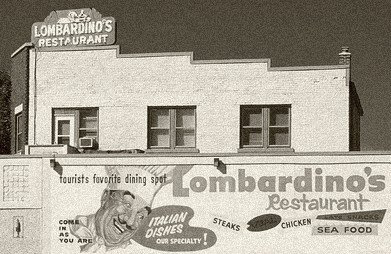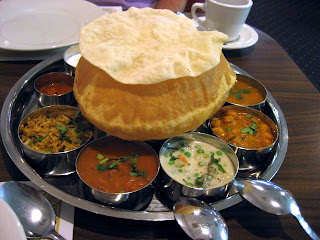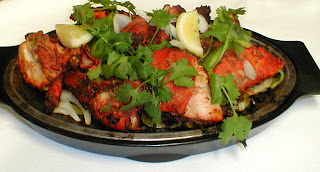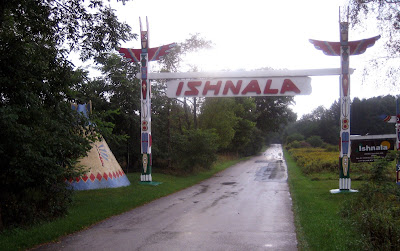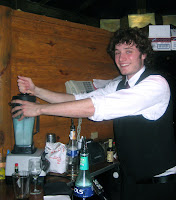
… Without Leaving Downtown Madison
DAY 1: MONDAY
Lunch, Costa Rica: Café Costa Rica
A Mango Man empañada (with Lizano salsa) and a mango smoothie.
Dinner, Japan: Kushi Bar Muramoto
Cosmos made with shochu, four assorted fried kushi (skip the quail egg) with the house hot sauce and a taco rice bowl.
DAY 2: TUESDAY
Lunch, Nepal: Himal Chuli
Momocha (vegetarian dumplings) served with ginger-tomato chutney.
Dinner, Greece: Plaka Taverna and Ouzeria
Taramosalata with pita, moussaka, a side salad and a shot of ouzo for dessert. Stini yamas!

DAY 3: WEDNESDAY
Lunch, Italy: Osteria, Papavero
Panzerotti (a fried calzone stuffed with tomato, fresh mozzarella and oregano) and a chinotto-flavored Pellegrino.
Dinner, Indonesia: Bandung
Rijsttafel for Two: Ten traditional dishes the likes of lumpia, gago gado and saté served with rice. Have a Heineken (since the “rice table” concept originated in Holland).
DAY 4: THURSDAY
Lunch, Ethiopia: Buraka
Misirwot – lentils, split peas and potatoes in a spicy tomato sauce eaten with injera (a spongy, sourdough sort of pancake).
Dinner, Spain: Icon
Tapas: cured Spanish meats and sausage with olives and Manchego, artichoke and fennel salad, potato and wild mushroom tortilla, beef empeñada, fried calamari. To drink, a bottle of Baron de Lay, Finca Monasterio. Flan with fresh berries to finish and off to Overture.
DAY 5: FRIDAY
Lunch, Afghanistan: Maza
An appetizer sampler plate – hummus, yogurt sauce, and cilantro chutney, pakowra (vegetable fritters) and bulani (fried potato dumplings). Maybe a bowl of soup, too.
Dinner, Ireland: Brocach
A Scotch egg and Guinness to start, then fish and chips … more Guinness (everything here is even better seated outside … or with more Guinness).
DAY 6: SATURDAY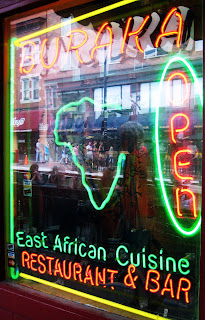
Lunch, China: Wah Kee
Pot stickers with Albert’s special hot sauce (it’s not on the menu you got to ask for it) and Szechuan dam dam noodles in broth.
Dinner, Brazil, Samba Brazilian Grill
Caipirinhas (of course) then a trip to the exotic Brazilian-style 40-item salad bar before a parade of grilled meats carved tableside by your friendly gaucho server.
DAY 7: SUNDAY
Brunch, France: Sardine
Half a dozen oysters on the half shell followed by a warm duck confit salad with lardons and a poached egg, a bottle of Veuve Clicquot Yellow Label and home for a nap.
Dinner, India: Maharani Indian Restaurant
A couple of samosas, lamb biryani, garlic naan and a Kingfisher. Tums perhaps?
DAY 1: MONDAY
Lunch, Costa Rica: Café Costa Rica
A Mango Man empañada (with Lizano salsa) and a mango smoothie.
Dinner, Japan: Kushi Bar Muramoto
Cosmos made with shochu, four assorted fried kushi (skip the quail egg) with the house hot sauce and a taco rice bowl.
DAY 2: TUESDAY
Lunch, Nepal: Himal Chuli
Momocha (vegetarian dumplings) served with ginger-tomato chutney.
Dinner, Greece: Plaka Taverna and Ouzeria
Taramosalata with pita, moussaka, a side salad and a shot of ouzo for dessert. Stini yamas!

DAY 3: WEDNESDAY
Lunch, Italy: Osteria, Papavero
Panzerotti (a fried calzone stuffed with tomato, fresh mozzarella and oregano) and a chinotto-flavored Pellegrino.
Dinner, Indonesia: Bandung
Rijsttafel for Two: Ten traditional dishes the likes of lumpia, gago gado and saté served with rice. Have a Heineken (since the “rice table” concept originated in Holland).
DAY 4: THURSDAY
Lunch, Ethiopia: Buraka
Misirwot – lentils, split peas and potatoes in a spicy tomato sauce eaten with injera (a spongy, sourdough sort of pancake).
Dinner, Spain: Icon
Tapas: cured Spanish meats and sausage with olives and Manchego, artichoke and fennel salad, potato and wild mushroom tortilla, beef empeñada, fried calamari. To drink, a bottle of Baron de Lay, Finca Monasterio. Flan with fresh berries to finish and off to Overture.
DAY 5: FRIDAY
Lunch, Afghanistan: Maza
An appetizer sampler plate – hummus, yogurt sauce, and cilantro chutney, pakowra (vegetable fritters) and bulani (fried potato dumplings). Maybe a bowl of soup, too.
Dinner, Ireland: Brocach
A Scotch egg and Guinness to start, then fish and chips … more Guinness (everything here is even better seated outside … or with more Guinness).
DAY 6: SATURDAY

Lunch, China: Wah Kee
Pot stickers with Albert’s special hot sauce (it’s not on the menu you got to ask for it) and Szechuan dam dam noodles in broth.
Dinner, Brazil, Samba Brazilian Grill
Caipirinhas (of course) then a trip to the exotic Brazilian-style 40-item salad bar before a parade of grilled meats carved tableside by your friendly gaucho server.
DAY 7: SUNDAY
Brunch, France: Sardine
Half a dozen oysters on the half shell followed by a warm duck confit salad with lardons and a poached egg, a bottle of Veuve Clicquot Yellow Label and home for a nap.
Dinner, India: Maharani Indian Restaurant
A couple of samosas, lamb biryani, garlic naan and a Kingfisher. Tums perhaps?
